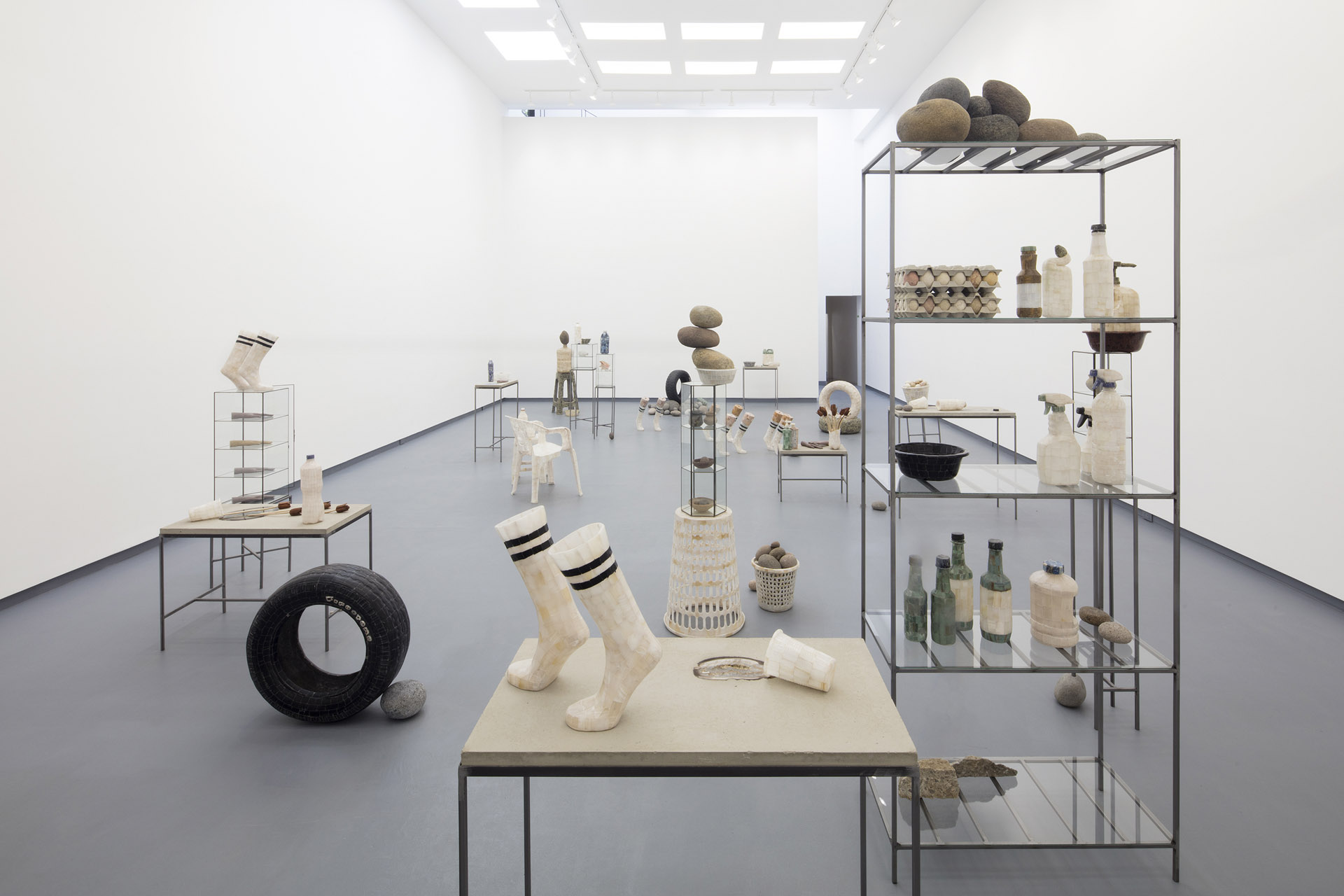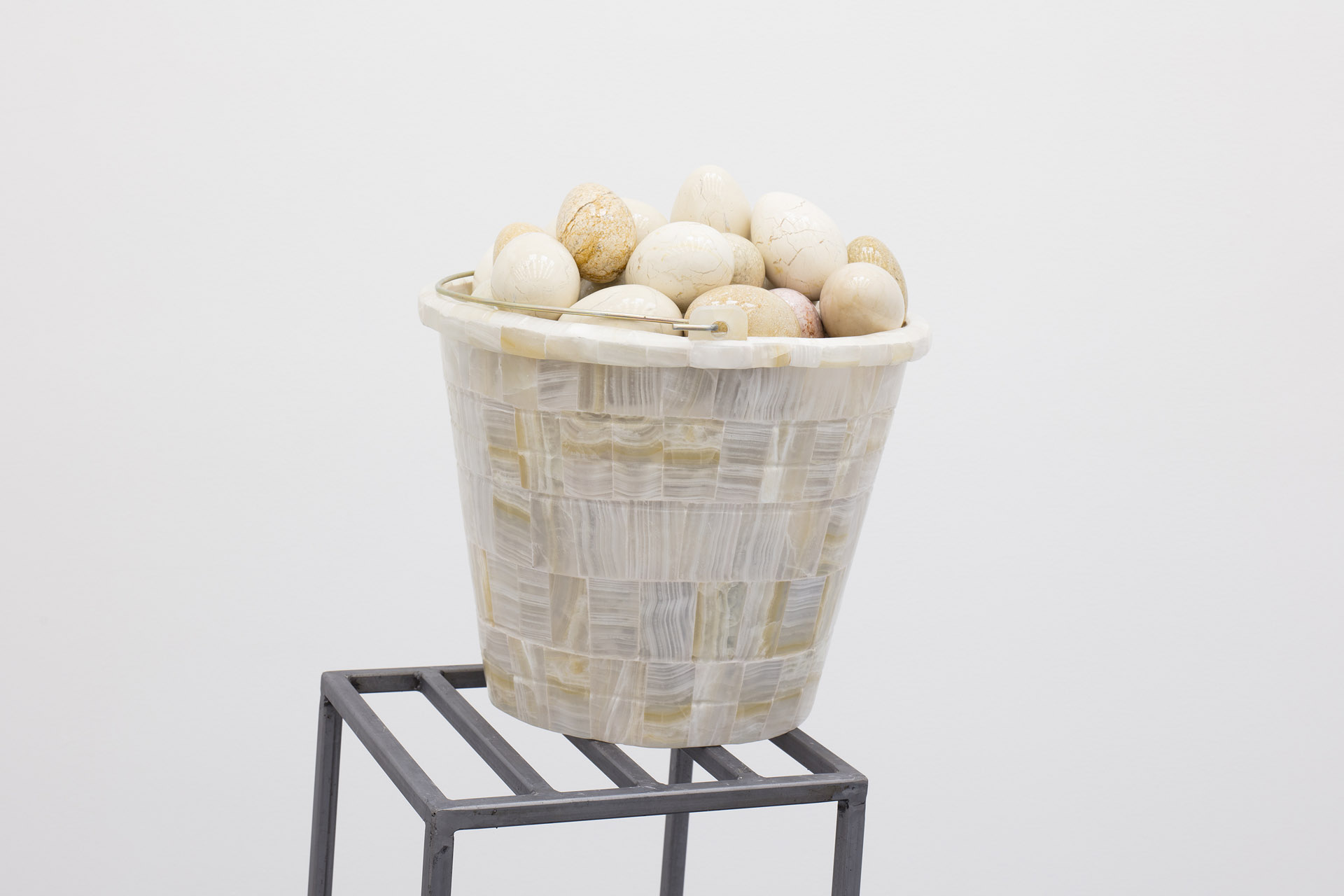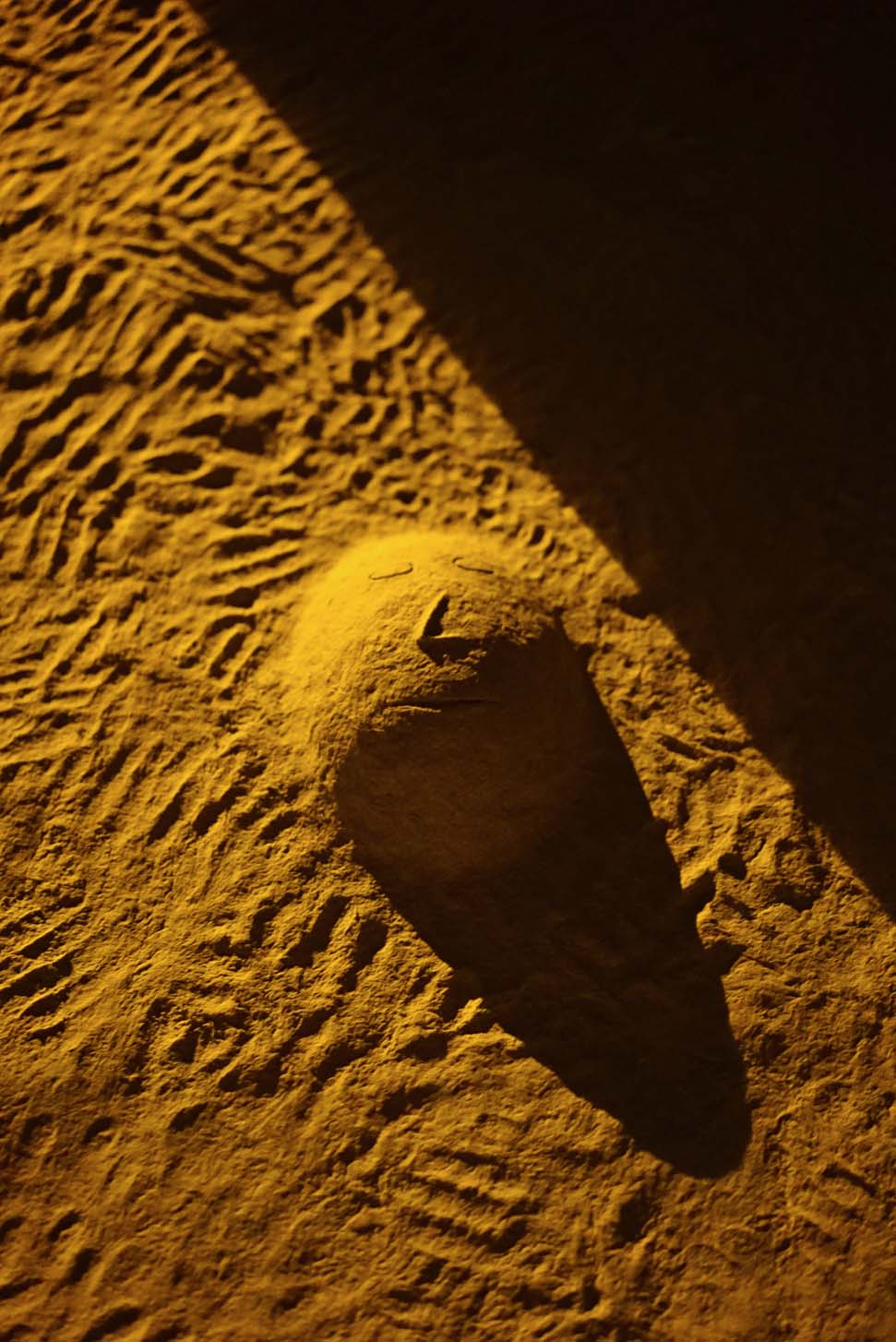Artist: Théo Mercier
Exhibition title: The Ballad of Disaster
Venue: Proyectos Monclova, Mexico City, Mexico
Date: March 18 – April 17, 2021
Photography: all images copyright and courtesy of the artist and Proyectos Monclova, Mexico City
Desired Stones, Desiring Stones Stones Passed by, Stones on the Move
Gabriela Jauregui
Through a trans-historical journey, by way of a metaphor that takes us from a traditional Mesoamerican sweat lodge to corn flour, Théo Mercier sculpts a material history: his objects — be they ingested, well-known, one’s own property/appropriated/consumed— tell us (im)proper history.
The works in this exhibition make apparent the micropolitics of microhistory. Behind every object there are tales of power, distribution, extraction, manufacture, of who buys it, who moves it and why. Every object branches out from that which is recounted; it is a fabrication of history.
Starting with his exhibition Every Stone Should Cry at the Musée de la Chasse et la Nature in Paris, and more recently in the show Silent Spring, Mercier has explored how to turn the still life into living, discursive matter. Here he takes that phantasmagoria further. “I stroll through a market the same way I go through a botanical garden,” Mercier says. As a flâneur out for a stroll, as a re-router of objects, the artist makes the exhibition into a petrified park, into shop selling souvenirs from a culture of domestic drama, or museum replicas from a civilization in decline. As in his two previous exhibitions, the plinths, showcases, vitrines, and pedestals are as important as what is displayed on top of or within them. Like goods for sale at a market, how and where the pieces are displayed makes all the difference in how we read them, and how we experience our movement among them: the artist’s juxtapositions create additional possible readings and meanings. There is also the latent presence of the titles of the pieces (taken from the lyrics of popular love songs in English and Spanish), which invoke the markets of Mexico City, especially La Merced, and their techniques of generating desire: they orient the gaze, and thus the economy. The exhibition thus becomes a stroll through a variety of scenes of different values and desires, because it is clear that an object in a glass case does not have the same “value” or generate the same desire as an object that can be touched.
With his sculptures, and by conceiving of the exhibition itself as a work of art, Mercier creates different relational situations, which is really more akin to the theatrical work of mise-en-scène than to sculpture as such. The work of art here is the social mobility of these objects, which climb and fall over time: from the marketplace at the foot of a temple 700 years ago to a stall at an open-air market in our own neoliberal world; a spray bottle that goes from being sold for 10 pesos to €15 million on its own aspirational journey. And because the pedestals on which they perch are so fragile, there is always the possibility of falling: this reveals to us or reminds us of the status of things, and moreover the status quo in the art world—everything is precarious. These objects are smoky mirrors of our different forms of precariousness, of the precariousness of life itself, in which everything is always on the verge of falling off a pedestal. And as the mise-en-scène emphasizes: the higher the pyramid, pedestal, or pile of avocados, the easier it is to fall, the harder the impact hits, the worse the bruise. In this sense, our movement through the exhibition also has a topographical quality, taking us from the lowest lows to the highest highs.
To think of it in another form, or to formulate it in another way of thinking: perhaps the exhibition itself is a giant vessel through which we move, a vessel that contains our stories about human beings and their objects. Indeed, in the spirit of Mercier himself, we could even do a little amateur archaeology: we might take note that almost everything in the exhibition is a container, a receptacle (covered, uncovered, upside-down), in the same way that much of what we see in archaeological museums also consists of various pots and receptacles. And if we were to do a bit of armchair anthropology, we would see that the display cases here recall both the displays of gelatin desserts at la Ciudadela no less than the showcases at a museum. As an object itself, the display case is more than just a container; it also tells us a story, lifts up, makes transparent— sometimes only itself, sometimes what it holds within.
The contents of this exhibition/vessel get jumbled up as if they were getting swirled around in a wine glass, yes, let’s get back to theatricality, since behind this mise-en-scène is, literally, what occurs “behind the curtain:” when the artist visited Palenque he observed that there was a garbage dump behind the sacred archaeological site; hence Mercier’s decision to extend his archaeology of the site to the garbage discarded mostly by tourists, and which now lives behind the ruins. Selecting some objects, another kind of ruin, he collaborated with Felipe Sebastián Ortega, a craftsman from Taxco who has dedicated himself to making reproductions of archaeological pieces, in order to make reproductions of garbage using the same materials as those used for museum reproductions. The garbage of the anthropocene has thus been made into an artifact, a souvenir. A petrified park has metamorphosed into a garden of toxic delights.
Our real and imaginary path forks into distinct possibilities: what happens if we put a plastic bottle in the market, the museum, a forest? What happens when it becomes a replica? Mercier tells us that the fakeness of replicas intrigues him, and that, unlike an original artifact, a replica can be part of his own story insofar as it was made for him, for you, for me, while the archaeological piece has more to do with a culture to which he does not belong.
What kinds of artifacts, memories and replicas populate this garden? Objects that allude to the world of truck and trade, along with their media of display: disembodied legs used to showcase stockings; hands in manicure stations; a parade of socks as if a ghostly soccer team were running alongside us; car parts. We also find another category of objects related to cleanliness, from the carwash to self-care. Made out of rose quartz, clear quartz, obsidian, onyx, serpentine, mother-of-pearl from abalone shells—the same materials that have been used for centuries in these lands— as we come to the end of our stroll, perhaps these objects can heal wounds as deep as the ones we are nursing now.
Théo Mercier, The Ballad of Disaster, installation view, PROYECTOS MONCLOVA, Mexico City, 2021, Photo: WhiteBalance
Théo Mercier, The Ballad of Disaster, installation view, PROYECTOS MONCLOVA, Mexico City, 2021, Photo: WhiteBalance
Théo Mercier, The Ballad of Disaster, installation view, PROYECTOS MONCLOVA, Mexico City, 2021, Photo: WhiteBalance
Théo Mercier, The Ballad of Disaster, installation view, PROYECTOS MONCLOVA, Mexico City, 2021, Photo: WhiteBalance
Théo Mercier, The Ballad of Disaster, installation view, PROYECTOS MONCLOVA, Mexico City, 2021, Photo: WhiteBalance
Théo Mercier, The Ballad of Disaster, installation view, PROYECTOS MONCLOVA, Mexico City, 2021, Photo: WhiteBalance
Théo Mercier, The Ballad of Disaster, installation view, PROYECTOS MONCLOVA, Mexico City, 2021, Photo: WhiteBalance
Théo Mercier, The Ballad of Disaster, installation view, PROYECTOS MONCLOVA, Mexico City, 2021, Photo: WhiteBalance
Théo Mercier, The Ballad of Disaster, installation view, PROYECTOS MONCLOVA, Mexico City, 2021, Photo: WhiteBalance
Théo Mercier, The Ballad of Disaster, installation view, PROYECTOS MONCLOVA, Mexico City, 2021, Photo: WhiteBalance
Théo Mercier, The Ballad of Disaster, installation view, PROYECTOS MONCLOVA, Mexico City, 2021, Photo: WhiteBalance
Théo Mercier, The Ballad of Disaster, installation view, PROYECTOS MONCLOVA, Mexico City, 2021, Photo: WhiteBalance
Théo Mercier, The Ballad of Disaster, installation view, PROYECTOS MONCLOVA, Mexico City, 2021, Photo: WhiteBalance
Théo Mercier, The Ballad of Disaster, installation view, PROYECTOS MONCLOVA, Mexico City, 2021, Photo: WhiteBalance
Théo Mercier, Freed from desire, mind and senses purified / Freed from desire / Nanananana nana nanana nanana (Gala), 2021, Hand carved black obsidian, onyx, jade and lapis lazuli stones, river stone and wood Overall dimensions: 72.5 x 160 x 172 cm
Théo Mercier, Detail: Freed from desire, mind and senses purified / Freed from desire / Nanananana nana nanana nanana (Gala), 2021, Hand carved black obsidian, onyx, jade and lapis lazuli stones, river stone and wood Overall dimensions: 72.5 x 160 x 172 cm
Théo Mercier, Detail: Freed from desire, mind and senses purified / Freed from desire / Nanananana nana nanana nanana (Gala), 2021, Hand carved black obsidian, onyx, jade and lapis lazuli stones, river stone and wood Overall dimensions: 72.5 x 160 x 172 cm
Théo Mercier, Every time I see you falling / I get down on my knees and pray / I’m waiting for that final moment / You’ll say the words that I can’t say (New Order), 2021, Metal, river stone, marble, hand carved onyx stone Overall dimensions: 98 x 60 x 60 cm
Théo Mercier, Detail: Every time I see you falling / I get down on my knees and pray / I’m waiting for that final moment / You’ll say the words that I can’t say (New Order), 2021, Metal, river stone, marble, hand carved onyx stone Overall dimensions: 98 x 60 x 60 cm
Théo Mercier, Detail: Every time I see you falling / I get down on my knees and pray / I’m waiting for that final moment / You’ll say the words that I can’t say (New Order), 2021, Metal, river stone, marble, hand carved onyx stone Overall dimensions: 98 x 60 x 60 cm
Théo Mercier, Lonely rivers flow / To the sea, to the sea / To the open arms of the sea (The Righteous Brothers), 2021, River stone, metal, glass cabinet, strombus shell, hand carved lapis lazuli and onyx Overall dimensions: 147 x 27.5 x 27 cm
Théo Mercier, Detail: Lonely rivers flow / To the sea, to the sea / To the open arms of the sea (The Righteous Brothers), 2021, River stone, metal, glass cabinet, strombus shell, hand carved lapis lazuli and onyx Overall dimensions: 147 x 27.5 x 27 cm
Théo Mercier, Detail: Lonely rivers flow / To the sea, to the sea / To the open arms of the sea (The Righteous Brothers), 2021, River stone, metal, glass cabinet, strombus shell, hand carved lapis lazuli and onyx Overall dimensions: 147 x 27.5 x 27 cm
Théo Mercier, Un-break my heart / Say you’ll love me again / Undo this hurt you caused / When you walked out the door / And walked out of my life (Toni Braxton), 2021, Metal, concrete, agate, wood, hand carved onyx and lapis lazuli Overall dimensions: 96 x 90 x 64 cm
Théo Mercier, Detail: Un-break my heart / Say you’ll love me again / Undo this hurt you caused / When you walked out the door / And walked out of my life (Toni Braxton), 2021, Metal, concrete, agate, wood, hand carved onyx and lapis lazuli Overall dimensions: 96 x 90 x 64 cm
Théo Mercier, Detail: Un-break my heart / Say you’ll love me again / Undo this hurt you caused / When you walked out the door / And walked out of my life (Toni Braxton), 2021, Metal, concrete, agate, wood, hand carved onyx and lapis lazuli Overall dimensions: 96 x 90 x 64 cm
Théo Mercier, Detail: Un-break my heart / Say you’ll love me again / Undo this hurt you caused / When you walked out the door / And walked out of my life (Toni Braxton), 2021, Metal, concrete, agate, wood, hand carved onyx and lapis lazuli Overall dimensions: 96 x 90 x 64 cm

































